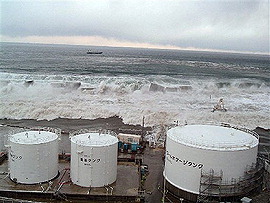News
TEPCO documents reveal chaos at Fukushima nuke plant after quake, tsunami
If there is one word to describe events at the Fukushima No. 1 Nuclear Power Plant in the immediate aftermath of the March 11 quake and tsunami -- with cooling systems failing and the worst nuclear disaster since Chernobyl brewing in its reactors -- it would be "chaos."
That is the picture painted by documents released by Tokyo Electric Power Co. (TEPCO) on May 16 describing the situation at the plant in the hours after tsunami slammed into the coastal facility. Coming more than two months after the disaster, the TEPCO data will soon be dissected by a government committee set up to analyze the causes of the nuclear crisis and the actions taken by both the government and TEPCO to contain it.
"The power-source trucks (to supply the reactors with outside power) are stuck in traffic!"
"We've given up on venting operations (to lower reactor vessel pressure). The radiation is just too high."
These are just two of the TEPCO employee reports included in the documents, which also lay out the exact chronology of events at the plant as the disaster unfolded.
At exactly 46 minutes and 46 seconds past 2 p.m. on March 11 -- just after the magnitude 9.0 earthquake had struck off the northeast coast of Japan -- reactors No. 1-3 began emergency shut-down procedures (reactors No. 4-6 were not operating). However, as the reactors were shutting down, the plant log reveals workers were being bombarded with alarms for control rod insertions in each reactor, water level fluctuations, and other details of a nuclear plant swinging into crisis-response mode.
According to the TEPCO documents, the tsunami hit at about 3:30 p.m., cutting all power at the plant. In response, at about 5 p.m. TEPCO ordered power-source trucks to head to the plant from its branches nearby. However, "the trucks were unable to make progress due to road damage and traffic jams," a report included in the documents states. Unable to get the trucks to the Fukushima plant, at 6:20 p.m., TEPCO requested neighboring Tohoku Electric Power Co. to send some in their stead.
The Tohoku Electric trucks did not arrive at the plant until about 11 p.m., but faced with "the dark, pools of tsunami water, missing manhole covers on the road, and debris everywhere hindering progress," workers found hooking up the necessary power cables extremely difficult, according to a report from around dawn on March 12. Power was finally restored to the plant at about 3 p.m., but at 3:36 p.m. a massive hydrogen explosion in the No.1 reactor building destroyed the newly laid cables, cutting power once more.
Meanwhile, workers inside the plant were trying to vent the No. 1 reactor to relieve pressure building in the reactor vessel. Reports made as the crisis went on show workers tried to vent the reactor manually at about 9:15 p.m. on March 11 but soon had to stop, with an entry at about 9:30 p.m. stating, "We tried the operation onsite, but the radiation dose was so high we gave up." The venting operation was eventually completed, but not until 10:17 p.m.
What the workers were doing between 9:30 p.m. and 10:17 p.m., however, is not revealed in the TEPCO documents, and a TEPCO representative told reporters, "We don't know what kind of risk assessment led the workers to try again."
However, an entry for 9:51 p.m. in the plant duty log also released by TEPCO states: "No entry permitted" to the No. 1 reactor building due to high radiation -- an order that photos of memos on the plant's central control room whiteboard show came directly from TEPCO President Masataka Shimizu. The high radiation that led to the no-entry order furthermore lends support to the theory that a core meltdown began soon after the tsunami struck.
While much of the detail surrounding TEPCO's immediate response to the disaster is included in the documents, there is no record of the utility's communications with the Prime Minister's Office, leaving government-TEPCO interactions over critical decisions such as the venting operation and the use of sea water for cooling a mystery.
![]() Click here for the original Japanese story
Click here for the original Japanese story
(Mainichi Japan) May 17, 2011













